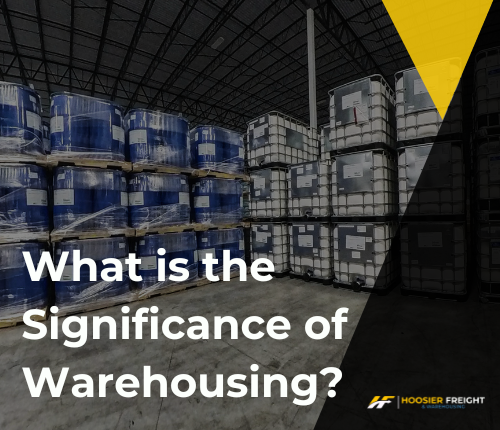
The Role of Warehousing in Logistics: An In-Depth Analysis
In the Freight and Warehousing sector, warehousing is not just a storage point but a critical logistics hub. The rise of e-commerce and changing consumer expectations have spotlighted warehousing’s strategic importance. It now encompasses activities crucial for the efficiency and agility of logistics, influencing everything from inventory management to customer satisfaction.
What is the Role of Warehousing in Logistics?
Warehousing within the logistics framework acts as a strategic buffer, enhancing the supply chain’s efficiency and reliability by aligning supply with demand through effective inventory management.
Central Role in the Logistics System
At its core, warehousing facilitates the smooth flow of goods from suppliers to consumers, acting as a critical buffer in the supply chain. It allows for the accumulation, sorting, and distribution of products, ensuring that supply matches demand with minimal delay. The main role of warehousing in the logistics system encompasses not only the storage of goods but also a range of activities including inventory management, order processing, and fulfillment.
Statistics from the Council of Supply Chain Management Professionals highlight that efficient warehousing can lead to a 20% reduction in overall logistics costs, underlining the strategic importance of warehousing in the logistics framework.
Strategic Importance
The strategic role of warehousing extends beyond mere storage, embracing technology to streamline and enhance logistics operations. Modern warehouses employ systems like Warehouse Management Systems (WMS), automated retrieval and storage systems (AS/RS), and advanced tracking technologies to optimize operations. This technological integration not only boosts efficiency but also provides real-time data analytics, enabling better decision-making and strategic planning in logistics.
A 2021 industry report by Logistics Management indicates that 75% of logistics companies now prioritize investment in warehouse technology to bolster their competitive edge, underscoring the pivotal role of advanced warehousing solutions in logistics.
What is the Relationship Between Logistics and Inventory?
Inventory management is central to warehousing, impacting logistics efficiency directly. Effective warehousing strategies ensure optimal inventory levels, preventing stockouts and excess stock.
Warehousing in Logistics Management
Warehousing’s contribution to logistics management is multifaceted, involving the coordination of various activities to ensure the efficient flow of goods. By implementing sophisticated inventory management systems, warehouses enhance visibility across the supply chain, facilitating accurate forecasting, efficient resource allocation, and timely order fulfillment.
The American Logistics Aid Network (ALAN) reports that incorporating advanced warehousing strategies can lead to a 30% improvement in order fulfillment accuracy, highlighting the symbiotic relationship between warehousing and logistics.
Warehouse and Logistics Difference
While warehousing is a subset of logistics focused on the storage and management of goods, logistics encompasses a broader spectrum of activities, including transportation, inventory management, and order fulfillment. The distinction lies in warehousing’s specialized role within the larger logistics operation, serving as the foundation upon which effective logistics strategies are built.
What is the Importance of Warehouse Location in Supply Chain Management?
Location plays a critical role in the efficacy of warehousing within the supply chain. Strategic warehouse placement can significantly impact transportation costs, delivery times, and overall logistics efficiency, making it a key consideration in logistics planning.
Critical Decision of Warehouse Location
Selecting the right location for a warehouse involves analyzing factors such as proximity to key markets, transportation networks, and suppliers. A well-located warehouse can dramatically reduce lead times and logistics costs, enhancing the competitiveness of businesses. Research from the Journal of Commerce indicates that strategic warehouse locations can reduce transportation costs by up to 25%, underscoring the importance of location in warehouse planning.
Logistics and Warehousing Companies
The strategic selection of warehouse locations by companies like Amazon, with its vast network of fulfillment centers placed near major urban centers, exemplifies the critical nature of location in minimizing delivery times and logistics costs.
What are the 4 Major Types of Warehousing?
Warehousing is not a one-size-fits-all operation; various types of warehouses cater to different needs within the logistics system. Understanding these differences is crucial for selecting the appropriate warehousing solution.
Public Warehouses
Public warehouses offer storage and logistics services to businesses on a contractual basis, providing flexibility and scalability. They are ideal for companies with variable storage needs or those looking to minimize capital investment in warehousing facilities.
Private Warehouses
Owned and operated by individual companies for their exclusive use, private warehouses offer greater control over storage and logistics operations. They are suited for businesses with stable, high-volume storage needs.
Bonded Warehouses
Bonded warehouses, regulated by customs authorities, are used for storing imported goods until customs duties are paid. They play a crucial role in international trade, offering a cost-effective solution for managing imported inventory.
Specialized Warehouses
Designed to handle specific types of goods, such as perishables, hazardous materials, or high-value items, specialized warehouses meet unique storage requirements, ensuring compliance with regulatory standards and product safety.
What are the 5 Areas of a Warehouse?
Effective warehouse management encompasses several critical areas, each integral to warehousing operations.
- Receiving Area: The entry point for goods, where shipments are inspected and sorted.
- Storage Area: Organizes and stores goods until they are needed.
- Picking Area: Selects items based on customer orders.
- Packing Area: Prepares items for shipment.
- Shipping Area: Dispatches goods to their destination.
Warehousing’s strategic role in logistics is undeniable, serving as the supply chain’s backbone. Through strategic inventory management and optimized operations, warehousing significantly contributes to logistics systems’ agility and competitiveness. As logistics continue to evolve, warehousing’s importance will only grow, highlighting its crucial role in the global economy.
Enhance your logistics operations with Hoosier Freight and Warehousing’s advanced solutions. Contact us today to learn how we can streamline your supply chain, reduce costs, and improve satisfaction.



